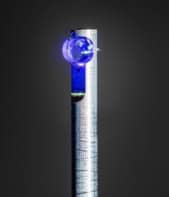Synchrotrons can be used to study delicate historical artefacts, but what if it were your prized possession in the beamline? Robert P Crease finds out

You can hardly blame the Norwegian musician Peter Herresthal for never letting anyone else play his 250-year-old violin. He bought it at an auction, with the help of a sponsor, for an eye-watering half a million dollars. “I don’t even let it out of my sight,” Herresthal told me. So for him to hand over the violin in October 2010 to a team of scientists at the Elettra synchrotron in Trieste, Italy – and then let them enclose it inside an X-ray beamline for two days – was a stupendous display of trust in science.
Operational since 1993, the Elettra facility has 27 different X-ray beamlines that are put to different uses. One beamline, known as SYRMEP (SYnchrotron Radiation for MEdical Physics), is often used by scientists to non-invasively examine archaeological specimens and ancient artefacts, including flutes and paper-pipe organs. These studies inspired a team of Elettra scientists to image a working violin – a cheap student model – with synchrotron light.
The resulting 3D images of the instrument – along with detailed information about its composition and manufacture – emboldened the researchers to seek a historically significant violin to image. Their thoughts immediately turned to the legendary “Cannon” violin that once belonged to the virtuoso Niccolò Paganini (1782–1840). One of the most famous instruments in the world, it was named after the explosive sounds Paganini could create with it.
Paganini’s Cannon is an Italian national treasure and is displayed in an earthquake-proof case in Genoa’s Palazzo Tursi; on the rare occasions it’s moved, it is ferried around in an armoured car. When the Elettra scientists approached its curator Alberto Giordano, he unsurprisingly didn’t feel comfortable lending it. Giordano, however, thought of his friend Herresthal, who had recently bought another historic violin, made in 1753 by the Piacenza instrument builder Giovanni Battista Guadagnini.
Herresthal was using the quality sound of the antique instrument to cement his reputation as a foremost expositor of contemporary violin music and also appeared reluctant. Although Giordano explained the procedure and assured Herresthal that the X-rays wouldn’t damage or alter the wood, Herresthal had other concerns too. “The violin’s wood is old and fragile,” he told me. “But the climate where I live in Norway is dry, and when you take the violin to a place with a different climate it affects the response.”
Herresthal eventually consented to the project but only after the Trieste scientists agreed to build a specially created environmental system that could control a sample’s temperature and humidity. And so it was that in October 2010 Herresthal and his wife put the violin in the back of their car and drove the 160 km down the autostrada from Venice, where he’d been teaching, to Trieste. Once there, a team of half a dozen scientists showed him the synchrotron and described how it works.
“They explained the technique, but I don’t know if I can explain it back!” Herresthal recalls. Staff then showed him the two-stage climate monitoring and control system they’d built. The first stage contained a humidifier and air conditioner designed to bring the climate to the target range of 55% relative humidity and 25 °C. The second consisted of a more precisely controlled environment inside a 50 × 50 × 130 cm Plexiglas box, equipped with an alarm that would ring in the control room should the humidity or temperature change.
Still, Herresthal’s first glimpse of Elettra’s experimental hall was a shock, crammed as it was with silver-foil-wrapped equipment and serviced by an overhead crane. “It looked like a scene from a James Bond movie just before everything blows up,” he says. “I remember how excited the scientists all were, but I was still worried.” Indeed, when Giordano asked Herresthal to remove his violin’s fittings to improve the imaging, Herresthal refused. He also said no when Giordano asked if the strings could be removed. “Hands off!” Herresthal recalls saying, worried about an upcoming performance in Kentucky. “If you remove the strings, the bridge can fall down.”
The scientists compromised, re-thinking their imaging plans. They mounted the violin on a support, closed off the experimental area from direct view, and began work. Two days later, they had a 3D digital image of the violin, resolving details down to 50 µm, presenting it in a way Herresthal could understand. “The images were remarkable,” he admits. “You could see all the repairs; I even saw a drop of glue.” When I asked Herresthal if the imaging changed his views about the violin, he agreed it had, saying it made him more confident. “It showed me there were no cracks and the repairs had been done well,” he says. “Sometimes you are tempted to open a violin to try to improve it; I’ll keep mine closed.” He also reckons violin imaging will change the market. “It won’t be possible to hide that a historic violin has cracks, or is heavily restored, or is made with composite materials.”
The critical point
One moment in this episode encapsulates what made the trust between Herresthal and the scientists possible, an encounter in which his respect for the scientists, and theirs for him, became most transparent. It took place after the first day, when the scientists had to stop to adjust the violin’s position. They asked Herresthal if he wanted to test it before they carried on.

Science and the Stradivarius
Herresthal, still worried, said yes. If anything were awry he would refuse to let them continue. He picked up the violin, raised the bow, and started to play. Music filled the experimental hall – some scales, followed by snippets of a piece by a Danish composer that Herresthal was planning to perform in Kentucky.
Satisfied with the sound, Herresthal smiled. He handed them back the violin. and said: “Go ahead.”



